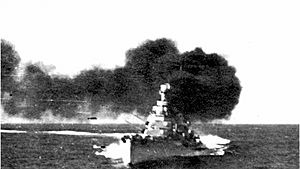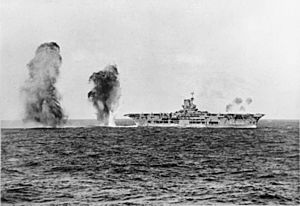Battle of Cape Spartivento facts for kids
Quick facts for kids Battle of Cape Spartivento |
|||||||
|---|---|---|---|---|---|---|---|
| Part of the Battle of the Mediterranean of the Second World War | |||||||
  Top: Italian heavy cruiser Bolzano during the battle. Bottom: British aircraft carrier Ark Royal straddled by enemy bombs |
|||||||
|
|||||||
| Belligerents | |||||||
| Commanders and leaders | |||||||
| Strength | |||||||
| 1 carrier 1 battleship 1 battlecruiser 1 heavy cruiser 5 light cruisers 1 anti-aircraft cruiser 15 destroyers 4 corvettes 3 freighters |
2 battleships 6 heavy cruisers 14 destroyers |
||||||
| Casualties and losses | |||||||
| 7 killed 1 heavy cruiser damaged 1 light cruiser slightly damaged |
1 destroyer damaged |
||||||
The Battle of Cape Spartivento, known as the Battle of Cape Teulada in Italy, was a naval battle during the Battle of the Mediterranean in the Second World War, fought between naval forces of the Royal Navy and the Italian Regia Marina on 27 November 1940.
Origins
On the night of 11 November 1940, the British incapacitated or destroyed half of the Italian fleet's battleships in a daring aerial assault as they lay at rest at Taranto. Until then, the Italians had left their capital ships in harbour, hoping its mere presence as a fleet in being would deter British shipping through the area, though they would not decline battle if given the opportunity.
Six days later, on the night of 17 November, an Italian force consisting of two battleships (Vittorio Veneto and Giulio Cesare) and a number of supporting units attempted to intercept two British aircraft carriers, HMS Ark Royal and Argus and their cruiser escorts, who were en route to Malta in an attempt to provide planes to reinforce that island's defenses (Operation White). The British were warned of their approach and immediately turned about and returned to Gibraltar, launching their aircraft (two Blackburn Skuas and 12 Hawker Hurricanes) prematurely. One Skua and eight Hurricanes were lost at sea, as they ran out of fuel well before arriving at their destination, with the loss of seven airmen.
The Italians' success in disrupting the reinforcement of Malta cast serious doubt upon British plans to send a further convoy to supply the island (Operation Collar). However, the convoy was attempted, with increased support, including ships from Gibraltar-based Force H and Force D out of Alexandria. The convoy was spotted by the Italian intelligence service, and once again the Italian fleet sailed out to intercept it. The first Italian naval unit to make visual contact with the convoy was the torpedo boat Sirio on the night of 26 November. After launching two torpedoes from long range, which missed their target, Sirio reported seven enemy warships heading to the east.
Battle
The British, aware of the Italian fleet's movements, sent their forces north to intercept them before they could come anywhere near the cargo ships. At 09:45 on 27 November, an IMAM Ro.43 reconnaissance floatplane from the heavy cruiser Bolzano discovered a British squadron steaming to the east, 17 nmi (31 km; 20 mi) north of Chetaïbi.
Shortly after, at 9:56, admiral James Somerville received the report of his own aircraft from the carrier HMS Ark Royal about the presence of five cruisers and five destroyers, and assumed that these were Italian units closing for battle. Force D had not yet arrived from Alexandria and the British were outgunned, but 15 minutes later, Force D was spotted and the tables turned. The two forces were fairly even; although the Italian ships possessed both longer-ranged and larger guns, the British had an aircraft carrier, which had shown several advantages over the battleship at Taranto. However, the Italian admiral Inigo Campioni had been given orders to avoid combat unless it was heavily in his favour, so a decisive battle was out of the question.
Admiral Somerville deployed his forces into two main groups, with five cruisers under Rear Admiral Lancelot Holland in front and two battleships and seven destroyers in a second group following to the south. Meanwhile, and even further to the south, Ark Royal was preparing to launch its complement of Fairey Swordfish. The Italians had organized their fleet into three groups, two composed of the six heavy cruisers and seven of the destroyers and a third group of the two battleships and another seven escorting destroyers bringing up the rear. At 12:07, after a report received from the cruiser Gorizia's floatplane, Campioni realized the closeness in strengths of the two forces and in accordance with his orders commanded the cruiser groups to re-form on the battleships and prepare to depart. However, by this point, the lead cruiser formation had already angled toward the British and was beginning to engage them in battle.
At 12:22, the lead groups of both cruiser forces came into range and Fiume opened fire at 23,500 metres (25,700 yd). Rapid fire between the two forces continued as the distance between them closed, but as the range shortened Italian firepower began to put pressure on the outgunned British. The arrival of the battleship HMS Ramillies on the British side helped to even the odds, but she was too slow to maintain formation and dropped out of battle after a few salvoes at 12:26. Four minutes later, Vice Admiral Angelo Iachino, commander of the Italian cruiser group, received orders to disengage, although the battle had swung slightly in their favour. Iachino ordered an increase in speed to 30 kn (56 km/h; 35 mph), laid smoke and started to withdraw.
At this time, the Italian destroyer Lanciere was hit by a broadside from HMS Manchester and seriously damaged, although she was towed to port after the battle. The heavy cruiser HMS Berwick was hit at 12:22 by a single 203 mm (8 in) shell, which knocked out her "Y" turret, killed seven men, wounded nine others and ignited a fire that took an hour to subdue. A second hit at 12:35 destroyed the after breaker (electrical switchboard) room and cut power to the ship's aft section, including the remaining aft turret. Most sources believe that the first hit was scored by an Italian heavy cruiser from the 1º Cruiser Division, either from Fiume or Pola, while the second round came from the 3º Cruiser Division, either from Trieste or Trento, at the time the only Italian warships within range.
At around 12:40, eleven Swordfish from Ark Royal attacked Vittorio Veneto with torpedoes, but did not score any hits.
For the next few minutes, the tables turned in favour of the British when the battlecruiser HMS Renown closed the distance on the Italian cruisers, and straddled Trieste with two salvoes. The Italian cruiser was hit by splinters. This advantage was soon negated, however, when at 13:00, Vittorio Veneto opened fire from 27,000 metres (30,000 yd). Vittorio Veneto fired 19 rounds in seven salvoes from long range and that was enough for the now outgunned British cruisers, which turned back at the fourth salvo. In fact, as giant water-spouts erupted around Berwick and Manchester, Holland ordered smoke, and his ships fled southeast to close with Renown. Manchester was holed by splinters from Vittorio Veneto's rounds. Both forces withdrew, the battle lasting a total of 54 minutes and causing little damage to either side.
Aftermath
After the battle Winston Churchill wanted Somerville to be replaced, having questioned the admiral's offensive spirit ever since his objections to attacking the French at Mers-el-Kebir. However, a board of inquiry exonerated Somerville, who enjoyed the strong support of several fellow admirals. As for Campioni, although he had a mandate to be conservative, he had presided over the loss of Italy's best opportunity to deal the British a sharp setback in a fleet action. His days of command at sea were numbered. As Iachino remarked, "the use of these ships, which constituted at that moment nearly all of our fleet's effective units after the blow at Taranto, was decided by Supermarina mainly for reasons of morale, and to demonstrate that our combative spirit remained intact."
Popular culture
The battle features in the 1941 Italian film The White Ship directed by Roberto Rossellini.
Order of battle
Regia Marina
- Admiral Angelo Iachino
- 6 heavy cruisers: Bolzano, Fiume, Gorizia, Pola, Trieste, Trento
- 7 destroyers: Ascari, Carabiniere, Lanciere (damaged), Alfredo Oriani, Vittorio Alfieri, Giosuè Carducci, Vincenzo Gioberti
- Admiral Inigo Campioni
- 2 battleships: Vittorio Veneto, Giulio Cesare
- 7 destroyers: Alpino, Bersagliere, Fuciliere, Granatiere, Dardo, Freccia, Saetta
- Admiral Sir James Somerville Force H (from Gibraltar)
- 1 battlecruiser: Renown
- 2 light cruisers: Sheffield*, Despatch (covered convoy)
- 1 aircraft carrier: Ark Royal (12 Fairey Fulmar fighters, 12 Blackburn Skua dive bombers, 30 Fairey Swordfish torpedo bombers)
- 9 destroyers
- Admiral Andrew Cunningham Force D (from Alexandria)
- 1 battleship: Ramillies
- 3 cruisers: Berwick*, Coventry (covered convoy), Newcastle*
- 5 destroyers
- Admiral Lancelot Holland Force F (convoy escort)
- 2 light cruisers: Manchester*, Southampton*
- 1 destroyer: Hotspur
- 4 corvettes: Gloxinia, Hyacinth, Peony, Salvia
'*'Cruiser force detached under Holland: 1 heavy cruiser: Berwick (damaged) and 4 light cruisers: Manchester (slightly damaged), Newcastle, Sheffield, Southampton
destroyers which approached the battle: Encounter, Faulknor, Firedrake, Forester, Fury, Hotspur
destroyers escorting Ark Royal during the battle: : Jaguar, Kelvin
destroyers covering the convoy during the battle: Defender, Duncan, Gallant, Greyhound, Griffin, Hereward, Wishart
- Convoy
- 3 freighters: Clan Forbes, Clan Fraser, New Zealand Star
See also
Presumed death of Jean Chiappe due to the shoot-down of mail plane La Verrier, theorised to have occurred during the battle.

